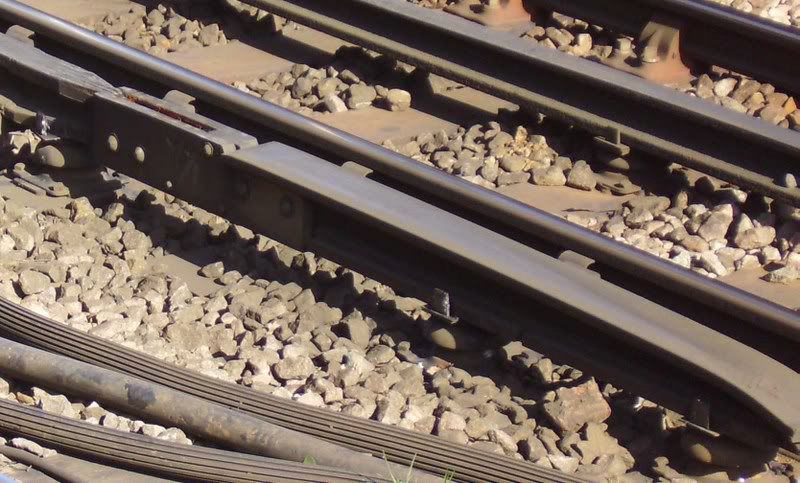Deleted
Deleted Member
Posts: 0
|
Post by Deleted on Mar 8, 2007 20:27:25 GMT
Can anyone tell me the purpose of this...? I spotted it on the e/b at Ealing Common, about level with the platform starter. When trains pass over it, they draw a big arc.  |
|
Deleted
Deleted Member
Posts: 0
|
Post by Deleted on Mar 8, 2007 21:30:32 GMT
It's a rail splay - it's designed to let the pickup shoe change levels when leaving or entering the rail. It keeps the shoes from being torn off.
|
|
Deleted
Deleted Member
Posts: 0
|
Post by Deleted on Mar 8, 2007 21:35:19 GMT
No - I meant the slotted bit between the splay and the ordinary +ve rail, that was where trains were arcing badly.
|
|
Deleted
Deleted Member
Posts: 0
|
Post by Deleted on Mar 8, 2007 21:57:05 GMT
It keeps the shoes from being torn off. Need a few of these on the Central! |
|
Deleted
Deleted Member
Posts: 0
|
Post by Deleted on Mar 9, 2007 2:14:16 GMT
they just allow the ramp to be bolted on instead of being welded on
|
|
Deleted
Deleted Member
Posts: 0
|
Post by Deleted on Mar 9, 2007 10:12:41 GMT
Actually that's an interesting point. I'm wondering if there is electrical continuity to the ramp ( there is obviously supposed to be ) as there seems to be no arc burns on that at all, just friction marks. It looks like the shoe is leaving the juice on entering the joiner.
|
|
Tom
Administrator
Signalfel?
Posts: 4,196 
|
Post by Tom on Mar 9, 2007 11:51:25 GMT
We had something similar on the bakerloo to reduce arcing.
|
|
Deleted
Deleted Member
Posts: 0
|
Post by Deleted on Mar 9, 2007 13:13:04 GMT
We had something similar on the bakerloo to reduce arcing. The arc occurs where the slot is, not as the shoe leaves the ramp. Both 73 and D stocks do it. |
|
Deleted
Deleted Member
Posts: 0
|
Post by Deleted on Mar 9, 2007 14:07:04 GMT
Different metal compound in that part which links the ramp and the main +ve rail???
|
|
Deleted
Deleted Member
Posts: 0
|
Post by Deleted on Mar 9, 2007 14:12:39 GMT
Maybe it acts like a big resistor whereby limiting the current to the actual ramp piece hence resrticting the maximum current the shoe can draw before it leaves the ramp thus reducing arcing. Where's Russ I'm sure he would know  |
|
|
|
Post by russe on Mar 9, 2007 18:51:41 GMT
Where's Russ I'm sure he would know  Hmmm, must admit I'm a bit stumped. If the purpose was merely to allow the ramp to be bolted on rather than welded, I don't think this complex construction would be used, since conventional metal fishplates would do the job better. On the assumption that the fishplate sides are wood (like on old-style section gaps using out-of-gauge rails), the purpose of the arrangement would seem to be to isolate the end of the ramp. But why do this? Reduce arcing? I'm not sure about that - any shoe is going to arc as it departs from juice proximity (this ramp is a trailing one), so why make the bridge so abrupt in this case rather than the conventional shape of a ramp. And from what David describes, the arcing here is pronounced. David - could I use your pic on my 3rd and 4th rails page please? Russ |
|
|
|
Post by stanmorek on Mar 9, 2007 18:55:13 GMT
I think its an arc suppression ramp. The arc is safely directed away from the track into the splice assembly.
A bad case of arcing can literally burn a hole into conductor rail if it isn't addressed soon enough.
|
|
|
|
Post by russe on Mar 9, 2007 19:46:28 GMT
Is the ramp in question this one: .jpg) or this one: .jpg) or is it neither of these? (cf: the lack of cable connector to the ramp in David's picture) Russ |
|
Deleted
Deleted Member
Posts: 0
|
Post by Deleted on Mar 9, 2007 20:06:29 GMT
It's the bottom picture.
You have a pm Russ.
|
|
solidbond
Staff Emeritus
'Give me 118 reasons for an Audible Warning on a C Stock'
Posts: 1,215
|
Post by solidbond on Mar 9, 2007 23:30:04 GMT
There are a number of these around the District line. They were installed a few years ago, and they are intended to reduce the arc drawn by trains going over gaps in the current rail. How effective they are, I'm not sure - since I can't normally see behind my train whilst driving  ;D |
|
Deleted
Deleted Member
Posts: 0
|
Post by Deleted on Mar 12, 2007 14:23:13 GMT
I think this answers the question. www.freepatentsonline.com/EP1339562.htmlIf you sign up on the free registration and view the images for this patent they are exactly as in Davids photo. Interesting reading. |
|



